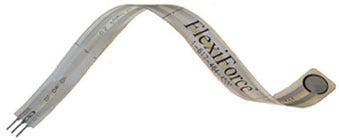Force Sensors Are Making Medical Devices Smarter
May 14, 2015
The practice of medicine has always been an art as well as a science. But, in the age of value-based care, the balance between those two is shifting in favor of the latter. Sensor-enabled medical devices are playing an important role in the trend.
Brian Buntz
|
The FlexiForce sensor from Tekscan is an example of a product that can help make medical devices smarter. |
In healthcare in the 21st century, data is king. Number crunchers in hospitals' procurement departments now wield considerable influence in the healthcare landscape. And group purchasing organizations (GPOs) are emerging as the Costco of healthcare--buying products in huge quantities and then selling them at discounted rates to members.
But healthcare needs more than hawking medical products at discounted rates; it needs a way to gauge their efficacy. It needs smarter medical devices.
A growing number of sensor-enabled medical devices are hitting the market, providing metrics for diagnoses and helping systematize how doctors deliver treatments.
Surgical tools are one example that could benefit from such technology. In the past, surgeons relied heavily on their training and experience to guide them in a procedure. Whether they squeezed a surgical instrument with the correct amount of pressure was determined largely based on experience.
Now, force sensors can be integrated into surgical grippers to help surgeons get a sense of the force they are applying. "The sensors can provide a surgeon with the feedback during a procedure that helps them avoid cutting a vital organ or vein," says Lisa Jones, marketing specialist, FlexiForce at Tekscan (South Boston, MA).
The problem is compounded by minimally invasive surgery, which has made an array of surgeries far less traumatic, but has taken away tactile feedback from surgeons.
Cambridge Research & Development has worked to bring haptic feedback to minimally invasive procedures, providing a surgeon with precise feedback, enabling them to feel as well as see what they are doing in a procedure.
A similar scenario exists in the realm of physical therapy, where practitioners deliver hands-on treatment. One study found that the amount of force applied by physical therapists could vary as widely as 500% among practitioners.
That variability not only makes it difficult to compare the efficacy of the therapy, it also increases the risk that patients will be hurt in its course.
Australian researchers tackled this problem by using FlexiForce load and force sensors from Tekscan to create a physical therapy training device to help coach students to use the precise amount of force required for manual evaluations.
"We've seen force sensors being used in a couple of prosthetics applications to actually give a sense of touch in the fingertips," Jones says.
Force sensing technology is also being employed in assisted living devices to help caregiver's monitor a patient's health remotely.
A "Maker"-esque example of where force sensors can come in handy can be found in the case of the 14-year-old Kenneth Shinozuka, recently winner of the Scientific American Science in Action Award and a $25,000 cash prize from the Davidson Institute. Shinozuka's grandfather has Alzheimer's and would occasionally wander out of the home disoriented. So the teenager came up with a wearable tracking device that can go in his grandfather's sock. Using an ultrathin film sensor, the device can detect when its wearer gets out of bed, relaying a signal to a caregiver's smartphone.
Force sensors can also be integrated into wearable drug-infusion or insulin pumps to detect early signs of occlusion and pump malfunction. The sensor can then help trigger a potentially life-saving alarm that there is a serious problem.
Learn more about electronics at MD&M East in New York City, June 9-11, 2015. |
Brian Buntz is the editor-in-chief of MPMN and Qmed. Follow him on Twitter at @brian_buntz.
Like what you're reading? Subscribe to our daily e-newsletter.
About the Author(s)
You May Also Like


.png?width=300&auto=webp&quality=80&disable=upscale)
